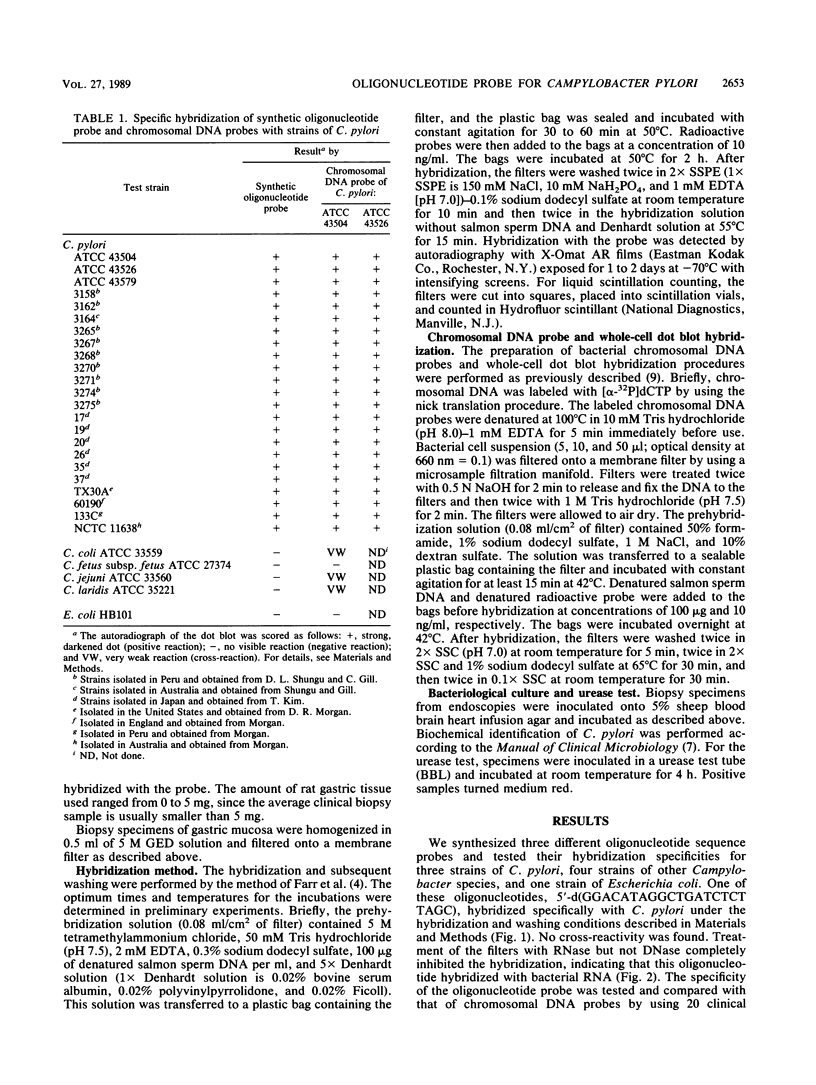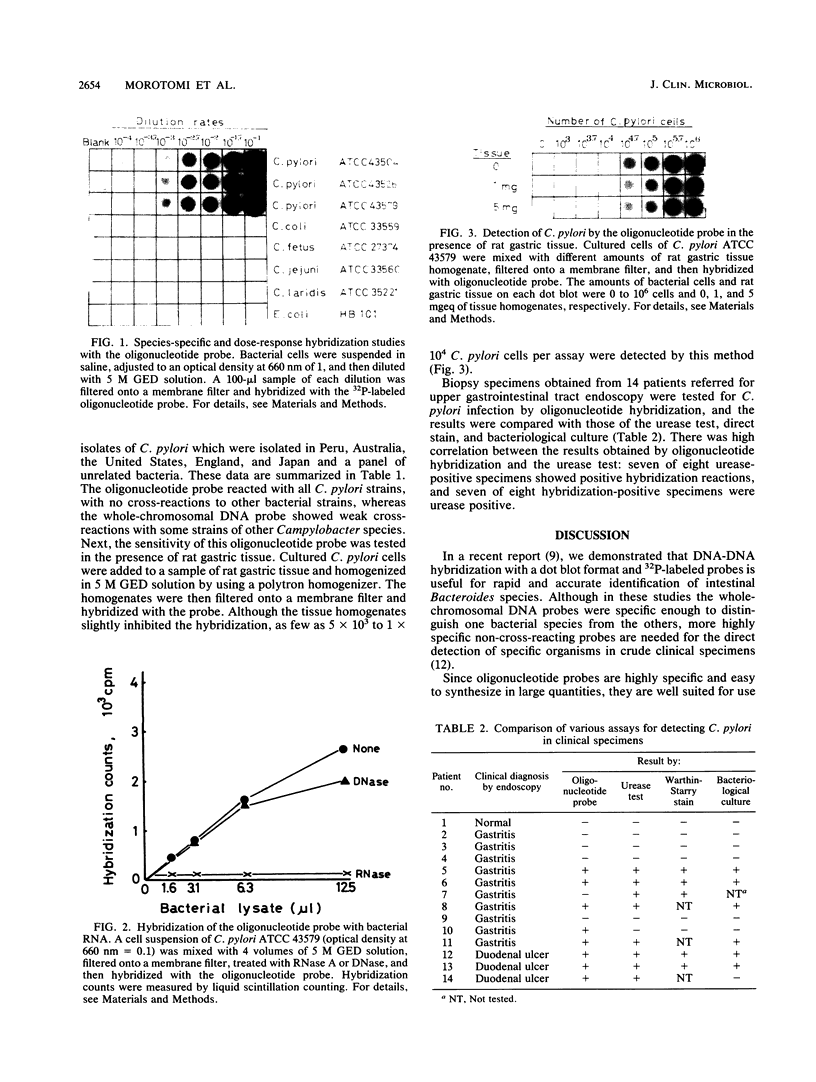Abstract
We have developed a novel and practical DNA-RNA hybridization assay for the detection and identification of Campylobacter pylori in the gastric mucosa. This technique utilizes a [32P]ddATP-labeled synthetic oligonucleotide probe complementary to a nucleotide sequence present in C. pylori 16S rRNA. This probe is very sensitive and reacted with all 23 strains of C. pylori tested. It is also highly specific, since there was no cross-reactivity with the heterologous organisms Campylobacter coli, C. fetus subsp. fetus, C. jejuni, and C. laridis or with Escherichia coli. Hybridization of the oligonucleotide probe with C. pylori RNA was completely inhibited by treatment of the membrane filters with RNase but not DNase. Although a gastric mucosa tissue homogenate slightly inhibited the hybridization, as few as 10(4) C. pylori cells could be detected even in the presence of 5 mg of gastric mucosa. Gastric biopsy specimens obtained from patients referred for upper gastrointestinal tract endoscopy were tested for C. pylori infection by direct oligonucleotide hybridization, and the results were compared with those of bacteriological cultures, the urease test, and histological observations. A comparison of the urease test and the oligonucleotide hybridization results showed an excellent correlation between the two methods. The clinical usefulness of this oligonucleotide-RNA hybridization method is discussed.
Full text
PDF



Images in this article
Selected References
These references are in PubMed. This may not be the complete list of references from this article.
- Blaser M. J. Gastric Campylobacter-like organisms, gastritis, and peptic ulcer disease. Gastroenterology. 1987 Aug;93(2):371–383. doi: 10.1016/0016-5085(87)91028-6. [DOI] [PubMed] [Google Scholar]
- Borromeo M., Lambert J. R., Pinkard K. J. Evaluation of "CLO-test" to detect Campylobacter pyloridis in gastric mucosa. J Clin Pathol. 1987 Apr;40(4):462–463. doi: 10.1136/jcp.40.4.462. [DOI] [PMC free article] [PubMed] [Google Scholar]
- Engstrand L., Pählson C., Gustavsson S., Schwan A. Monoclonal antibodies for rapid identification of Campylobacter pyloridis. Lancet. 1986 Dec 13;2(8520):1402–1403. doi: 10.1016/s0140-6736(86)92049-0. [DOI] [PubMed] [Google Scholar]
- Farr C. J., Saiki R. K., Erlich H. A., McCormick F., Marshall C. J. Analysis of RAS gene mutations in acute myeloid leukemia by polymerase chain reaction and oligonucleotide probes. Proc Natl Acad Sci U S A. 1988 Mar;85(5):1629–1633. doi: 10.1073/pnas.85.5.1629. [DOI] [PMC free article] [PubMed] [Google Scholar]
- Hazell S. L., Borody T. J., Gal A., Lee A. Campylobacter pyloridis gastritis I: Detection of urease as a marker of bacterial colonization and gastritis. Am J Gastroenterol. 1987 Apr;82(4):292–296. [PubMed] [Google Scholar]
- Humphreys H., Bourke S., Dooley C., McKenna D., Power B., Keane C. T., Sweeney E. C., O'Moráin C. Effect of treatment on Campylobacter pylori in peptic disease: a randomised prospective trial. Gut. 1988 Mar;29(3):279–283. doi: 10.1136/gut.29.3.279. [DOI] [PMC free article] [PubMed] [Google Scholar]
- McNulty C. A., Wise R. Rapid diagnosis of Campylobacter-associated gastritis. Lancet. 1985 Jun 22;1(8443):1443–1444. doi: 10.1016/s0140-6736(85)91865-3. [DOI] [PubMed] [Google Scholar]
- Morotomi M., Ohno T., Mutai M. Rapid and correct identification of intestinal Bacteroides spp. with chromosomal DNA probes by whole-cell dot blot hybridization. Appl Environ Microbiol. 1988 May;54(5):1158–1162. doi: 10.1128/aem.54.5.1158-1162.1988. [DOI] [PMC free article] [PubMed] [Google Scholar]
- Romaniuk P. J., Zoltowska B., Trust T. J., Lane D. J., Olsen G. J., Pace N. R., Stahl D. A. Campylobacter pylori, the spiral bacterium associated with human gastritis, is not a true Campylobacter sp. J Bacteriol. 1987 May;169(5):2137–2141. doi: 10.1128/jb.169.5.2137-2141.1987. [DOI] [PMC free article] [PubMed] [Google Scholar]
- Sommerfelt H., Kalland K. H., Raj P., Moseley S. L., Bhan M. K., Bjorvatn B. Cloned polynucleotide and synthetic oligonucleotide probes used in colony hybridization are equally efficient in the identification of enterotoxigenic Escherichia coli. J Clin Microbiol. 1988 Nov;26(11):2275–2278. doi: 10.1128/jcm.26.11.2275-2278.1988. [DOI] [PMC free article] [PubMed] [Google Scholar]
- Tompkins L. S., Krajden M. Approaches to the detection of enteric pathogens, including Campylobacter, using nucleic acid hybridization. Diagn Microbiol Infect Dis. 1986 Mar;4(3 Suppl):71S–78S. doi: 10.1016/s0732-8893(86)80044-x. [DOI] [PubMed] [Google Scholar]




